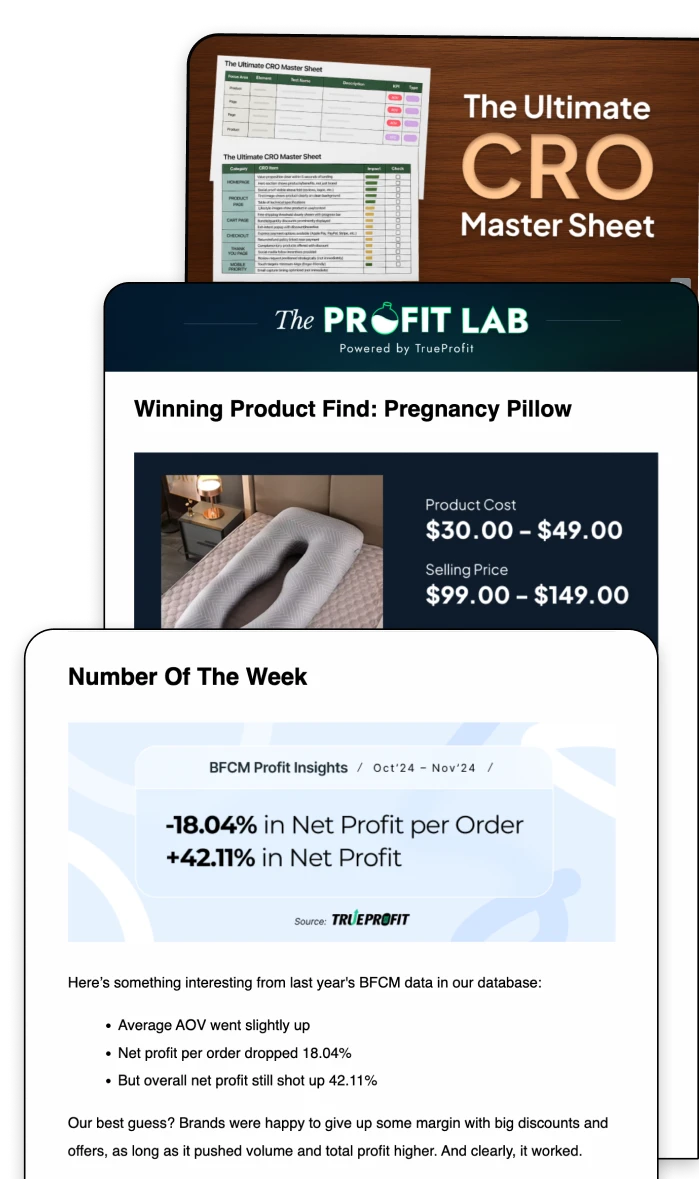Profit and Loss (PNL)? Simple Guide for E-com Businesses (2025)

Profit and loss (PnL) statements are vital in the world of finance. They provide a comprehensive overview of a business's financial performance, including its revenue, expenses, and profits over a specific period.
By looking at PnL statements, businesses can evaluate their financial health, make informed business decisions, and identify areas for improvement.
Some commonly asked questions about PnL statements include: “What is PnL?”, "What is the difference between revenue and net income?" and "How can I use a PnL statement to make informed business decisions?".
All those questions will be clarified in today’s article. Let's dive in!
What Is PNL?
PnL statements, also known as income statements, are financial documents that show a business's revenue, cost of goods sold, gross profit, operating expenses, operating profit, and net profit.
- What is PnL: An abbreviation for "Profit and Loss", also known as “P&L”.
- What PnL tracks: Earned money vs spent money.
- What PnL informs: if you run at a profit or a loss throughout that time.
A profit and loss statement summarizes all the activity recorded in your income and expenses accounts over the specified time. Income typically includes sales while expenses might cover things like payroll, advertising, rent, and insurance.
The statement will include all sales, including credit sales that your customers might not have paid yet. It will also include bills for expenses that you have incurred but not paid.
Your total profit or loss is what you’ve earned minus what you’ve spent:
- If this amount is positive, it’s called net income.
- If it’s negative, it’s called a net loss.
These statements are prepared at the end of a business's financial period, be it monthly, quarterly, or annually. They are used to evaluate a business's financial performance, make informed business decisions, and identify areas for improvement.
How Can A Profit & Loss (PnL) Report Drive Business Growth?
PnL statements are an essential tool for businesses looking to evaluate their financial performance, make informed business decisions, and identify areas for improvement.
Profit and loss statements are important for businesses because they:
- Evaluate financial performance: Offer insights into a business's financial health, including revenue, expenses, and profits.
- Make informed business decisions: Helps businesses make strategic decisions, such as increasing revenue or cutting expenses.
- Identify areas for improvement: Businesses can identify areas for improvement.
- Assess financial health and potential for growth: Assess a business's financial health and potential for growth.
- Identify risks and opportunities for growth: Highlight potential risks and opportunities for growth.
- Track financial progress over time: Comparing PnL statements from different periods helps businesses track their financial progress over time.
- Provide insights into financial performance: Offer valuable insights into a business's financial performance.
- Help businesses make informed decisions: Provide essential information for businesses to make informed decisions about future goals and strategies.
Overall, these statements are a crucial part of a business' financial management, offering insightful information about performance and assisting you in making profit-driven choices regarding long-term objectives or strategies.
How To Read a Profit & Loss (PnL) Report?
Now that you understand the basics of PnL, let's break down how to read a PnL report effectively. A profit and loss statement consists of six key components, grouped into two categories:
- Revenue & Profitability Metrics – Show how much your business earns and retains.
- Expenses & Cost Metrics – Detail the costs involved in running your business.
To accurately assess financial performance, you need to understand these six essential components:
1. Revenue
The total income generated from sales before deducting any expenses. It’s a key metric that reflects business growth.
2. Cost of Goods Sold (COGS)
This indicates the costs a business expended in creating the products or services it sold. Raw material expenses, direct labor charges, and other direct costs are included. A crucial part of a PnL statement is COGS since it sheds light on a business's manufacturing expenses.
3. Gross Profit
The profit after subtracting COGS from revenue. This indicates how efficiently your business produces and sells goods.
4. Operating Expenses
The costs of running daily business operations, such as salaries, rent, utilities, and marketing. Monitoring these expenses helps optimize spending.
5. Operating Profit
The profit left after deducting operating expenses from gross profit. This metric highlights how efficiently your business is managed.
6. Net Profit
This is the total amount of money left over after deducting all expenses from revenue. Net profit is a critical component of a PnL statement because it provides insights into a business's overall financial health.
Overall, understanding these components helps businesses analyze revenue streams, production costs, and operating expenses to make informed financial decisions.
What Risk Factors Affect Your Profit & Loss (PnL) Report?
1. Changes in Market Demand
If demand decreases, the business may experience a decline in revenue, which can negatively impact the PnL report. On the other hand, if demand increases, the business may experience an increase in revenue, leading to a positive impact on the statements.
2. Increases in Production Costs
PnL can be affected if production costs increase, such as materials or labor. This can lead to a decrease in profits, which can negatively impact the overall profit and loss. Companies need to be cautious when making decisions that can lead to increased production costs, as it can impact their bottom line.
3. Changes in the Regulatory Environment
Companies need to stay up to date with changes in the regulatory environment to ensure they are operating in compliance with regulations.
For example, new taxes or regulations can result in increased costs for the business, which can negatively impact the PnL.
4. Fluctuations in Currency Exchange Rates
This affects especially if the business has operations in multiple countries. If the currency exchange rate changes, it can impact the business's revenue and expenses, leading to a positive or negative impact, depending on the direction of the change.
5. Natural Disasters/Unforeseen Events
In rare cases, some events can disrupt business operations, impacting the business's financial performance. These circumstances are uncontrollable and unpredictable, most of the time.
For example, if a business's production facility is damaged by a natural disaster, it can lead to a delay in production, and a decrease in revenue, which can negatively impact the PnL.
How to Analyze a Profit & Loss (PnL) Report?
Maximize your PnL report with these 6 steps:
- Set Clear Goals – Define targets like increasing revenue or cutting expenses to track progress.
- Monitor Performance – Review statements regularly to spot areas for improvement.
- Identify Trends – Compare past reports to recognize patterns and make data-driven decisions.
- Benchmark Against Competitors – Measure performance against industry standards to stay competitive.
- Consult Experts – Work with accountants or finance professionals for accurate insights.
- Combine with Other Reports – Use alongside balance sheets and cash flow statements for a complete financial picture.
By following these steps, you can turn your PnL report into a powerful tool for business growth.
What Is The Best Way To Create A Profit & Loss (PnL) Report?
Creating a P&L statement can be done in two ways: manually or automatically.
1. The Manual Approach: Traditional Accounting Methods
Many businesses rely on spreadsheets or accounting software to compile their P&L statements using either:
- Cash accounting method: Records transactions when cash is received or paid. Simple but can be misleading.
- Accrual accounting method: Records transactions when they occur, regardless of cash flow. More accurate but complex.
While these methods work, they require time-consuming calculations, constant updates, and financial expertise to ensure accuracy. Additionally, manual tracking increases the risk of errors, making it harder to get a clear, real-time picture of profitability.
2. The Automatic Approach: TrueProfit, Real-Time PnL Reporting
For Shopify merchants, there's a smarter, automated way to track profits—TrueProfit. Instead of juggling spreadsheets or relying on estimations, TrueProfit gives you an accurate, real-time P&L report in a single dashboard.
✅ Automatically tracks revenue, costs, and net profit
✅ Provides real-time insights with zero manual work
✅ Helps you identify your most profitable products & marketing channels
Let's take a look at a P&L report made by TrueProfit. You can see all the ins and outs of your biz in one single dashboard.


Users of TrueProfit can monitor their profit margins, determine which of their items are the most profitable, and improve their pricing strategies to boost profits. With TrueProfit, you eliminate the hassle of manual calculations and gain full financial clarity to make data-driven decisions.
Final Thoughts
Preparing and analyzing PnL statements is key to understanding your business's financial health. By doing it right, businesses can make profit-driven decisions.
But manually handling PnL reports can be time-consuming and prone to errors. That’s where TrueProfit comes in—giving you real-time, accurate insights into your net profit so you can cut unnecessary costs, optimize margins, and scale with confidence.
Start tracking what truly matters—your net profit.
Discover what proper profit-tracking looks like at trueprofit.io
Irene Le is the Content Manager at TrueProfit, specializing in crafting insightful, data-driven content to help eCommerce merchants scale profitably. With over 5 years of experience in content creation and growth strategy for the eCommerce industry, she is dedicated to producing high-value, actionable content that empowers merchants to make informed financial decisions.






 Shopify profits
Shopify profits

